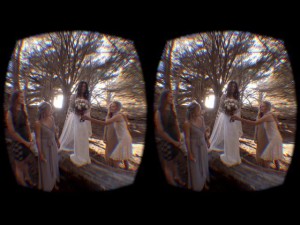Virtual Reality Filmmakers Say Questions Outnumber Answers — And That’s Okay
 A new short film called “Zero Point,” released by a different cinematic VR company called Condition One, briefly achieved presence for me in a seemingly pastoral scene of bison walking through a field. My head naturally followed the bison along their path, but I noticed they were turning to look back at the rest of their herd — so I turned, too, only to get a face full of curious beast.
A new short film called “Zero Point,” released by a different cinematic VR company called Condition One, briefly achieved presence for me in a seemingly pastoral scene of bison walking through a field. My head naturally followed the bison along their path, but I noticed they were turning to look back at the rest of their herd — so I turned, too, only to get a face full of curious beast.
“‘Oh! The bison is right there!’” Condition One CEO Danfung Dennis quoted another viewer as having said. “Everyone has that experience.”
In reality, of course, the animal was inspecting Dennis’s 3-D camera rig, which probably looked out of place in the middle of a field. But as a viewer, taking the place of that camera, I instinctively leaned away to try and get some distance from a thing that wasn’t there.
So, if it’s possible to get presence, what are the problems?
“The screen resolution is really perfect now if you hold it at arm’s length,” Christensen said of his Nexus 5, a premium Android phone. “When you bring it up to your eyes, with lenses, suddenly you need more.”
Another big aid to presence that you won’t find in the first round of cinematic VR content is positional tracking. What that means in layman’s terms: You can turn your head to see more of a scene happening all around you, but you can’t currently move your head or body to inspect different facets of a 3-D object. When the bison came up to inspect me in “Zero Point,” I leaned away out of instinct but my perceived distance from it stayed the same.
Christensen and Dennis said positional tracking in live-action video is possible, to an extent. Dennis speculated that the best way to achieve this is to use special depth-sensing cameras, similar to the Xbox’s Kinect, to collect data about how far away objects are from the various normal-camera lenses. This information could make the 3-D effect of a video more dynamic, changing as users move their heads around, though it still wouldn’t get a bison out of my face.
When the camera does need to move, slow movement may be the worst kind for motion sickness.
“In traditional filmmaking, you ramp the camera up to speed and ramp it slowly down to stop,” he said. “In VR, you want to go instantly from zero to 60. It minimizes the mismatch between your inner ear and what your mind is seeing.”
And some kinds of movement are just unworkable. Dennis said a scene in “Zero Point,” shot from the perspective of someone slowly riding down an escalator, had to be cut because the artificial altitude change made a lot of viewers sick.
Jules Urbach, the CEO of Los Angeles-based rendering company OTOY, said VR is a “very easy sell” in Hollywood at the moment.
“VR is something that all six major studios and other content creators take very seriously,” Urbach said. “At this point, everyone kind of gets it. They remember Cinerama: Three screens were more immersive than one. Movie studios understand that greater immersion is a big deal.”
Read the full story here: http://recode.net/2014/11/20/virtual-reality-filmmakers-say-questions-outnumber-answers-and-thats-okay/?curator=MediaREDEF
Pages
- About Philip Lelyveld
- Mark and Addie Lelyveld Biographies
- Presentations and articles
- Tufts Alumni Bio